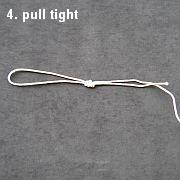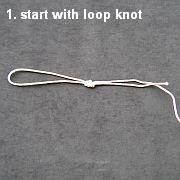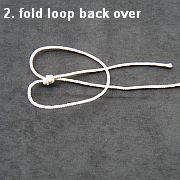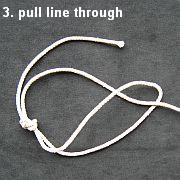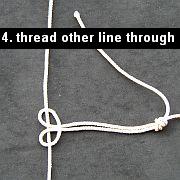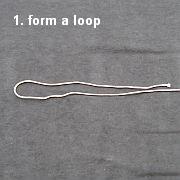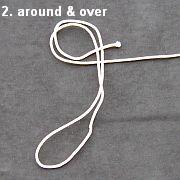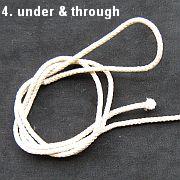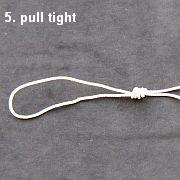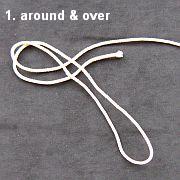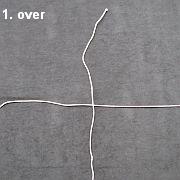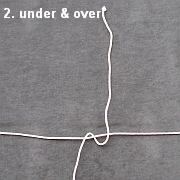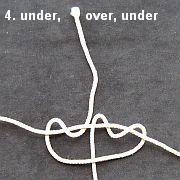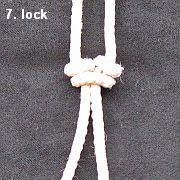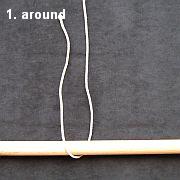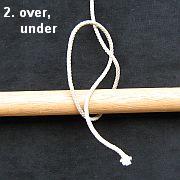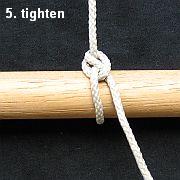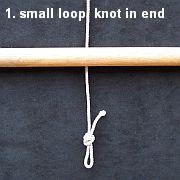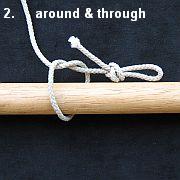
Knot Tying InstructionsFor All The MBK KitesThese knot tying instructions are long over-due! I used to get comments like 'The kite-making instructions are great, but I have trouble with the knots...' Time to fix this problem for good! I hope my approach of using multiple close-up photos will make each and every knot a breeze to do.Some knots are used together, for example the Loop Knot which is part of the Lark's Head Knot. These are grouped together below. However, apart from those, the knots below appear in no particular order. I hope the headings in these knot tying instructions make them very easy to find, whichever one you are after. Some of these knots are only here because I used them in one of the earliest MBK kites, and there's still a reference to it in the instructions. Eventually, when all the designs are re-done, I might only use 4 different knots or so for the lot. To put together these images, I used 2 lengths of old Nylon braided rope and a broom handle. The backdrop for each knot tying illustration was soft black cloth. The text below each group of photos just ...errrm .... ties in that knot to how it is used in the MBK series of kites. The Simple Overhand Loop Knot
This is the simple loop I used for all the 1-Skewer kites, mainly for making a Lark's Head Knot (see below). The other main use for this knot is simply to provide a large knot to stop slippage. For example, in the Single-wrap Slip Knot, also described further down this page. Another example is the short line which connects the flying line to the kite bridle. The Loop Knot stops the Lark's Head from slipping off the end of the short line. The Lark's Head Knot
The loop of the first photo can be any kind of Loop knot. There are 3 to choose from in these knot tying instructions! An amazingly simple yet useful knot. The great thing about this one is that no matter how tightly it gets stressed while holding all the tension of a flying line, it is fairly easy to remove. Regarding getting it loose again, here are a couple of tricks I discovered from experience...
Every MBK kite uses a short connecting line between the bridle and the flying line. The flying line is attached to this connector with a Lark's Head, making it easy to swap the line from kite to kite. The Double Overhand Loop Knot
This loop knot is significantly stronger than the simple overhand loop. However, it's almost as easy to tie. Just wrap the loop around twice instead of once. That's it. The tightened knot also looks a little bigger than the knot in the simple loop. Use this knot on the end of your flying line. The Figure-Eight Loop Knot
This loop knot is also significantly stronger than the simple overhand loop. It's a fishing knot, and just a little trickier to tie. Many kite people use this knot on the end of their flying lines. One day I'm going to get around to doing some tests to see if it really is stronger than the Double Overhand Loop Knot.. The results will be reported in these knot tying instructions! The Prusik Knot
Where would kite-fliers be without this great shiftable knot... A bit of a pain to tie at first, but it makes adjusting a bridle so easy! Pulling the bridle straight unlocks the knot, letting you shift it along the bridle line. Pulling on the lines as pairs as in the last photo causes the knot to fold, locking it in place. This mountaineering knot was invented in 1931 by Dr.Karl Prusik. With one 's'. Ooops. At least this page of knot tying instructions has got it right. Eventually we'll update all the other pages on this site that refer to the 'Prussik Knot'... The Half Hitch Knot
Half hitches are handy because they are so easy. Doing 2 or 3 at a time as in the photos is enough to secure a line to a rod such as a bamboo skewer or wooden dowel. However, as I have discovered, the top hitch will soon come undone if you don't secure it with a tiny dob of glue! It's easy to add even more hitches, but even these will all eventually come undone if not glued. The Single-Wrap Slip Knot
A small Simple Overhand Loop Knot in the end of the line prevents this slip knot from coming undone. At least in theory! In practice, the loop can still loosen off with handling, allowing even a loop knot to slip through. Again, a tiny dob of glue will make the knot permanent after it is first tied and tightened. The Double-Wrap Slip Knot is exactly the same as the Single-Wrap Slip Knot, except you wrap the line around the rod twice before pulling the loop knot through. It would still be a good idea to secure it with glue. I hope you found these knot tying instructions useful. One day, we'll get a high-end digital camera and update it all with better images... Last updated: 23 Dec 2008 Return to How To Make A Kite from Knot Tying Instructions All the way back to Home Page |



